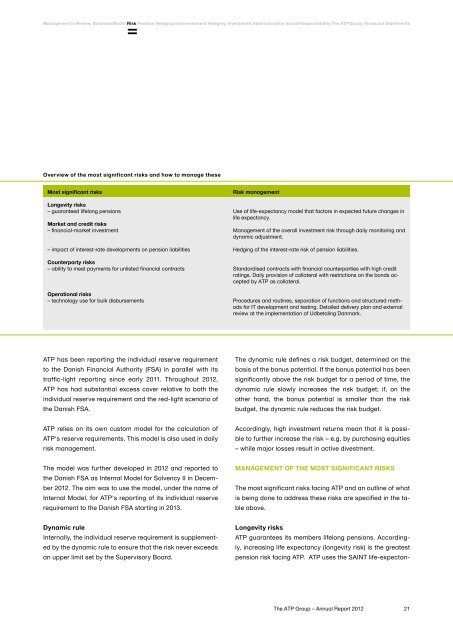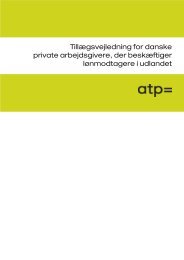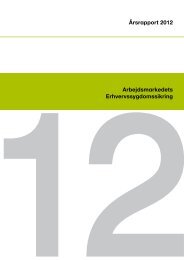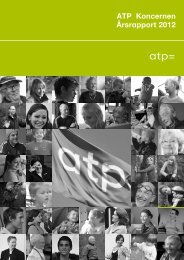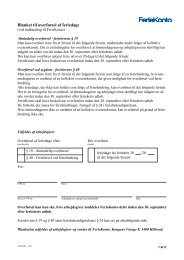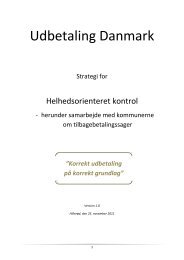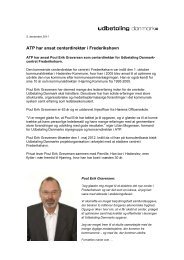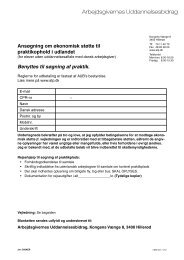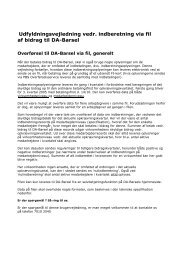The ATP Group Annual Report 2012
The ATP Group Annual Report 2012
The ATP Group Annual Report 2012
You also want an ePaper? Increase the reach of your titles
YUMPU automatically turns print PDFs into web optimized ePapers that Google loves.
Management's Review Business Model Risk Pension Hedging and investment Hedging Investment Administration Social Responsibility <strong>The</strong> <strong>ATP</strong> <strong>Group</strong> Financial StatementsOverview of the most significant risks and how to manage theseMost significant risksLongevity risks– guaranteed lifelong pensionsMarket and credit risks– financial-market investment– impact of interest-rate developments on pension liabilitiesCounterparty risks– ability to meet payments for unlisted financial contractsOperational risks– technology use for bulk disbursementsRisk managementUse of life-expectancy model that factors in expected future changes inlife expectancy.Management of the overall investment risk through daily monitoring anddynamic adjustment.Hedging of the interest-rate risk of pension liabilities.Standardised contracts with financial counterparties with high creditratings. Daily provision of collateral with restrictions on the bonds acceptedby <strong>ATP</strong> as collateral.Procedures and routines, separation of functions and structured methodsfor IT development and testing. Detailed delivery plan and externalreview at the implementation of Udbetaling Danmark.<strong>ATP</strong> has been reporting the individual reserve requirementto the Danish Financial Authority (FSA) in parallel with itstraffic-light reporting since early 2011. Throughout <strong>2012</strong>,<strong>ATP</strong> has had substantial excess cover relative to both theindividual reserve requirement and the red-light scenario ofthe Danish FSA.<strong>The</strong> dynamic rule defines a risk budget, determined on thebasis of the bonus potential. If the bonus potential has beensignificantly above the risk budget for a period of time, thedynamic rule slowly increases the risk budget; if, on theother hand, the bonus potential is smaller than the riskbudget, the dynamic rule reduces the risk budget.<strong>ATP</strong> relies on its own custom model for the calculation of<strong>ATP</strong>'s reserve requirements. This model is also used in dailyrisk management.Accordingly, high investment returns mean that it is possibleto further increase the risk – e.g. by purchasing equities– while major losses result in active divestment.<strong>The</strong> model was further developed in <strong>2012</strong> and reported tothe Danish FSA as Internal Model for Solvency II in December<strong>2012</strong>. <strong>The</strong> aim was to use the model, under the name ofInternal Model, for <strong>ATP</strong>'s reporting of its individual reserverequirement to the Danish FSA starting in 2013.MANAGEMENT OF THE MOST SIGNIFICANT RISKS<strong>The</strong> most significant risks facing <strong>ATP</strong> and an outline of whatis being done to address these risks are specified in the tableabove.Dynamic ruleInternally, the individual reserve requirement is supplementedby the dynamic rule to ensure that the risk never exceedsan upper limit set by the Supervisory Board.Longevity risks<strong>ATP</strong> guarantees its members lifelong pensions. Accordingly,increasing life expectancy (longevity risk) is the greatestpension risk facing <strong>ATP</strong>. <strong>ATP</strong> uses the SAINT life-expectan-<strong>The</strong> <strong>ATP</strong> <strong>Group</strong> – <strong>Annual</strong> <strong>Report</strong> <strong>2012</strong>21


